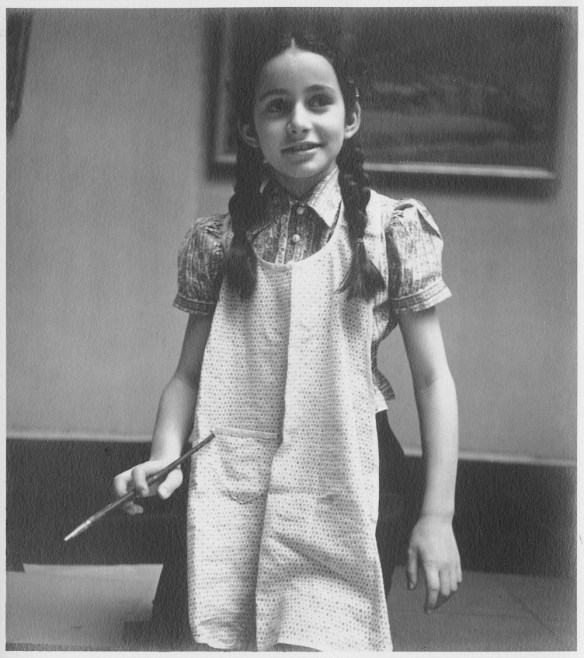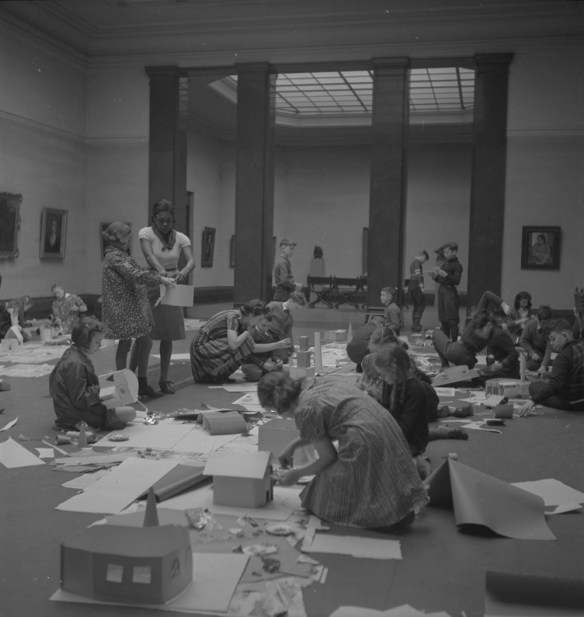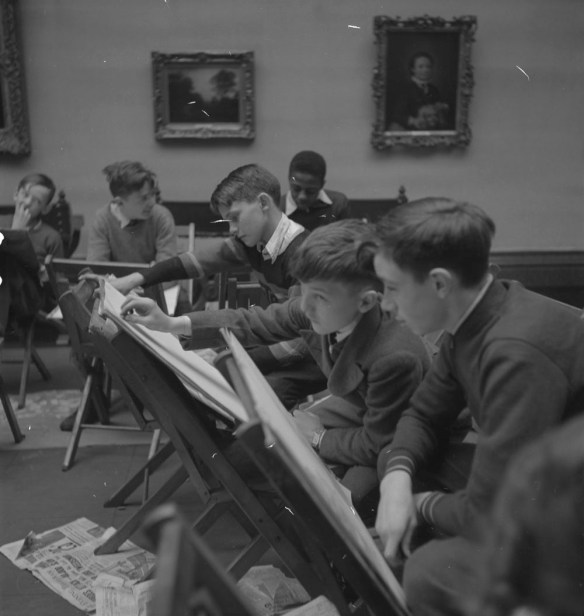By Brianna Fitzgerald
As COVID-19 restrictions have suspended in-person children’s programming, the rush of energy, noise and creativity often found on early weekend mornings at art galleries across the country now seems like a distant memory. Since art classes and workshops have moved online to adapt to these times, we are in a period of great innovation in the sphere of children’s art education, meeting new challenges in engaging children’s creativity in a virtual space. This is not the first time that there has been a major shift in the way that children’s art education is delivered. In the 1930s, Group of Seven painter Arthur Lismer (1885–1969) attempted to radically shift how Canada thought about art education and to transform the art gallery from a formal space into a vibrant community space.
When I came across images of Lismer’s children’s art classes in the Ronny Jaques fonds in the Library and Archives Canada collection, I felt a rush of memories of my own childhood spent in art classes and the frenzied excitement of little hands and young minds at work making things. Before finding these images, I was unaware of the large role that being an art educator played in Lismer’s life, and his tireless efforts to popularize and emphasize the importance of art education. I was also unaware of how closely his model of education in the 1930s matched what I grew up with decades later. Children’s art classes in Canada grew in popularity across the country in the 1930s, and much of the growth was due to Lismer’s hard work and innovation.

Girl with paintbrush at Arthur Lismer’s children’s art classes in Toronto (e010958789)
In 1929, when Lismer was appointed supervisor of education at the Art Gallery of Toronto (now the Art Gallery of Ontario), he began implementing many programs in line with his desire to democratize art, make it accessible to the average person and turn the gallery into a community space. Lismer’s first successful program was gallery tours for schools, which became part of the curriculum for some grades in the Toronto Board of Education. Lismer then launched Saturday morning children’s art classes. Teachers and principals from local schools would nominate their best art students to be invited to take part in the classes at the Art Gallery of Toronto. There was no tuition for these classes, only a small fee for material costs, and students had the chance to earn a scholarship for a junior course at the Ontario College of Art (now OCAD University).
With roughly 300 students attending the classes each week, the gallery was a lively place on Saturday mornings. Children were allowed to work freely and encouraged to explore their ideas and creative impulses. Children took part not only in painting and drawing, but also in clay sculpting, creating costumes, and acting in pageants. The classes were held within the galleries themselves, with children spreading out across the floor to work in various media, always in the presence of great works of art hung on the gallery’s walls. Throughout the 1930s and 1940s, exhibitions of work from children in the Saturday morning classes were a regular feature on the gallery’s calendar.

Children participating in Lismer’s children’s art classes (e010980053)
The Saturday classes would eventually result in the opening of the Art Centre at the Art Gallery of Toronto, which would facilitate education activities for the gallery. The Art Centre allowed for smaller classes and more direct interaction with each child, and it expanded the possibilities of Lismer’s vision. After several successful years of running the program at the Art Centre, Lismer was invited to undertake a lecture tour across the country to talk about Canadian art and the children’s art classes. Lismer had already been giving talks for teachers in Toronto to teach them about art and his own methods, hoping it would find its way into their lessons. With the lecture tour, Lismer had the chance to change how art was taught across the country.
The Art Gallery of Toronto was not Lismer’s first or last venture into children’s art education. Lismer ran Saturday morning classes at the Victoria School of Art and Design (now the Nova Scotia College of Art and Design) in Halifax in 1917, where he was the principal at the time. Following his tenure in Toronto and his cross-Canada lecture tour, Lismer became the educational supervisor at the Montreal Museum of Fine Arts in 1940. He once again established an Art Centre and education programming, as he had done in Toronto. Lismer continued to be involved with the Art Centre in Montréal, even after his retirement in 1967, until his death in 1969 at age 83.

Boys painting in Lismer’s children’s art classes (e010980075)
There are over a hundred images available to view online from these children’s art classes, which depict the wide variety of activities that Lismer developed for his education programming. These photographs give us a delightful peek at the classes some 80 years later. They welcome us to familiar scenes of children sprawled out on gallery floors, gathering art materials, painting at makeshift easels or sculpting in clay over tables well wrapped with newspaper. Although art classes for kids look and sound different during the pandemic, we can all look forward to having noise, mess and excitement take over gallery spaces on weekend mornings once again.
If you recognize someone, a location in the museum or a piece of art in the Arthur Lismer children’s art classes Co-Lab challenge, please tag the photograph!
Brianna Fitzgerald is a Digital Imaging Technician in the Digital Operations and Preservation Branch at Library and Archives Canada.

My mother and aunt attended Lismer’s classes at the Montreal Museum of Fine Arts. Children took turns tidying up the classroom at the end of class; when it was her turn, my mother saved two of Lismer’s teaching sketches before they went in the trash. One of these hung on the wall in our home when I was a child — a hasty charcoal drawing intended to show perspective, it illustrated the interior of a city bus full of people and a small elephant. These sketches needed better preservation — they had been drawn in charcoal on cheap newsprint — and were donated to the McMichael Collection in the 1990s.
Audrey Taylor was a teacher in Lismer’s art school in Montreal. Later, her genre was sculpting pieces of junk welded together. I was the owner of a foundry using the lost wax process for industrial customers. She had discovered that I also encouraged sculptors to let us cast their pieces at cost on a pro bono basis. After we had reproduced three for her in bronze for museums, she became a family friend. One day when she came for dinner she brought a framed Lismer sketch from her teaching days for our young children. She commented that when the child started to sketch an elephant, Lismer took hold of the child’s hand and guided it. It hangs in our bedroom waiting for a decision as to which child it should be given. Unfortunately it is unsigned with no identifying marks on the front or the back giving it no commercial value. But much sentimental value.